What is it?
Florida is home to an incredibly diverse array of ecosystems, ranging from coastal dunes and coral reefs to freshwater marshes and hardwood forests. This environmental richness supports thousands of plant and animal species, many of which are found nowhere else in the world. However, this natural diversity is increasingly under threat, with over 100 species threatened with the risk of extinction. Endangered species refers to animals, plants, and other organisms that are at serious risk of extinction across all or part of their natural range.
In Florida, human activities are the leading drivers of species endangerment. Rapid urban development and suburban sprawl have replaced natural habitats with roads, buildings, and lawns. Wetlands have been drained, forests cleared, and waterways polluted, leaving wildlife with shrinking areas to feed, breed, and migrate. Rising sea levels caused by climate change are inundating critical coastal and island habitats. Additionally, invasive species introduced by human actions often outcompete or prey upon native wildlife. Roadkill, boat strikes, and illegal hunting or poaching also remain persistent threats. Together, these pressures are pushing many native species toward the brink of extinction, making conservation efforts more urgent than ever.
Why it matters.
Endangered species are not just individual losses; they are critical parts of larger ecosystems. Each species plays a unique role in maintaining ecological balance. For example, pollinators like butterflies and birds support plant reproduction, predators keep prey populations in check, and scavengers help recycle nutrients. The disappearance of even a single species can trigger cascading effects, disrupting food webs and leading to further losses. This process, known as a trophic cascade, can degrade entire ecosystems over time.
Moreover, Florida’s biodiversity provides direct benefits to people. The state’s natural landscapes attract millions of visitors each year, contributing billions to the tourism and recreation economy. Healthy marine ecosystems support commercial and recreational fishing, which are vital industries in coastal communities. Many of Florida’s native plants and animals also hold scientific, cultural, and even medical value.
Protecting endangered species is not just about saving individual animals or plants; it’s about preserving the integrity of Florida’s natural heritage, ensuring long-term environmental health, and protecting the services these ecosystems provide to people. Every conservation effort today helps secure a livable, thriving Florida for generations to come.
Ways to help!
Protecting Florida’s endangered species starts with individual and community action. You can help by preserving natural habitats: planting native species, avoiding harmful chemicals, and reducing water and plastic use all support local ecosystems. When visiting parks or beaches, follow wildlife-friendly practices like staying on trails and respecting nesting areas.
Supporting conservation groups through donations, volunteering, or advocacy strengthens larger efforts. Stay informed about environmental issues, research policies that protect natural spaces, and share what you learn with others. Even small steps, when taken by many, can have a big impact on preserving Florida’s unique and irreplaceable biodiversity.
Meet some of Florida’s local endangered species
Take a trip down memory lane with our Know Your Florida posts to learn about 5 endangered species that call Florida home. These posts were shared over the past few years, and all the species featured are still officially listed as endangered in the state:
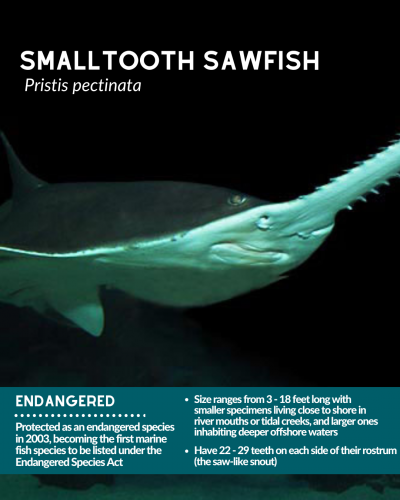 Smalltooth Sawfish: Is that a shark? Nope! It’s the smalltooth sawfish! Though their appearance and movements are similar to those of sharks, they are actually a type of ray. Like stingrays, they have gill slits on the bottom of their bodies. The rostrum, or the saw, is used to slash through schools of fish, and it also contains electro-sensitive organs that can detect low amounts of electricity, helping them to find shrimp and crabs on the ocean floor. The smalltooth sawfish is one of five species of sawfish found worldwide, and the only species in Florida waters. They rely on estuaries, especially red mangrove forests, to birth their young and to live in during their first two years of life. These estuaries have become threatened by habitat loss due to waterfront development. They were the first species of marine fish to be protected under the Endangered Species Act in 2003. Though it is illegal to harvest them, accidental catches of these fish are another factor contributing to their dwindling numbers. In the US, they were once found in the Gulf from Texas to Florida and along the East Coast from Florida to North Carolina. Today the species is only found off the coast of Florida.
Smalltooth Sawfish: Is that a shark? Nope! It’s the smalltooth sawfish! Though their appearance and movements are similar to those of sharks, they are actually a type of ray. Like stingrays, they have gill slits on the bottom of their bodies. The rostrum, or the saw, is used to slash through schools of fish, and it also contains electro-sensitive organs that can detect low amounts of electricity, helping them to find shrimp and crabs on the ocean floor. The smalltooth sawfish is one of five species of sawfish found worldwide, and the only species in Florida waters. They rely on estuaries, especially red mangrove forests, to birth their young and to live in during their first two years of life. These estuaries have become threatened by habitat loss due to waterfront development. They were the first species of marine fish to be protected under the Endangered Species Act in 2003. Though it is illegal to harvest them, accidental catches of these fish are another factor contributing to their dwindling numbers. In the US, they were once found in the Gulf from Texas to Florida and along the East Coast from Florida to North Carolina. Today the species is only found off the coast of Florida.
- Information from the Florida Museum of Natural History, Florida Fish and Wildlife Conservation Commission, and NOAA Fisheries.
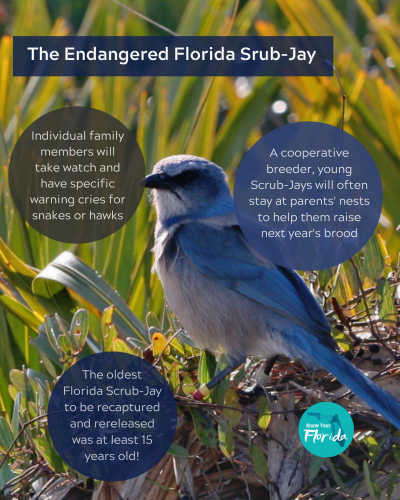 Florida Scrub Jay: The endangered Florida Scrub-Jay is the only bird species to live exclusively in Florida. Sporting blue and gray feathers, these small songbirds can most often be seen perched above shrubs or hopping along roadsides. Highly faithful to their home range, the birds rarely move away from the small and scarce habitat of the Florida scrub. Florida Scrub-Jays have also been the subject of multiple field studies due to their complex social behaviors and extended family groups.
Florida Scrub Jay: The endangered Florida Scrub-Jay is the only bird species to live exclusively in Florida. Sporting blue and gray feathers, these small songbirds can most often be seen perched above shrubs or hopping along roadsides. Highly faithful to their home range, the birds rarely move away from the small and scarce habitat of the Florida scrub. Florida Scrub-Jays have also been the subject of multiple field studies due to their complex social behaviors and extended family groups.
- Information from All About Birds and the Audubon Society. Image by Mary Keim (CC BY-NC-SA 2.0).
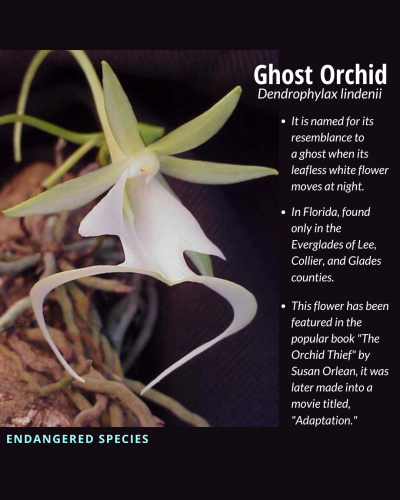 Ghost Orchid: The ghost orchid is endangered and exceptionally rare, found only in the Everglades of Lee, Collier, and Glades counties. The fragility of the species is due in part to the specific conditions it needs to live in – a climate with high humidity, mild temperatures, and a type of fungus with which it must form a symbiotic relationship in order to thrive. They are also difficult to cultivate from seed and have suffered declines due to habitat destruction and overcollection. Most of these plants only have one bloom at a time, but a “super” ghost orchid is on view at Corkscrew Swamp Sanctuary that once hosted 12 simultaneous blooms.
Ghost Orchid: The ghost orchid is endangered and exceptionally rare, found only in the Everglades of Lee, Collier, and Glades counties. The fragility of the species is due in part to the specific conditions it needs to live in – a climate with high humidity, mild temperatures, and a type of fungus with which it must form a symbiotic relationship in order to thrive. They are also difficult to cultivate from seed and have suffered declines due to habitat destruction and overcollection. Most of these plants only have one bloom at a time, but a “super” ghost orchid is on view at Corkscrew Swamp Sanctuary that once hosted 12 simultaneous blooms.
- Information from the Florida Museum of Natural History, National Park Service, Corkscrew Swamp Sanctuary, and FL Native Orchids. Photo from Mick Fournier / HBI Producers of Fine Orchids (CC BY 2.5).
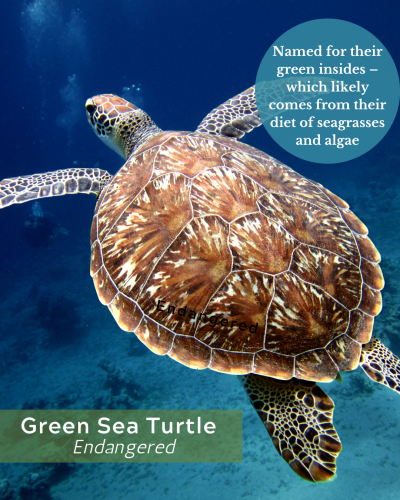 Green Sea Turtle: Green sea turtles can be found throughout Florida’s marine waters and nest along much of Florida’s coastline. In fact, Florida is home to one of the largest green turtle nesting groups in the western Atlantic! Green sea turtles get their name from their insides. Their body fat is green, likely from all the algae and seagrasses they eat as part of their herbivorous diet. These turtles are considered endangered, and face threats from fishing gear and marine debris entanglement, boat strikes, nesting habitat loss or degradation, disease, and egg poaching.
Green Sea Turtle: Green sea turtles can be found throughout Florida’s marine waters and nest along much of Florida’s coastline. In fact, Florida is home to one of the largest green turtle nesting groups in the western Atlantic! Green sea turtles get their name from their insides. Their body fat is green, likely from all the algae and seagrasses they eat as part of their herbivorous diet. These turtles are considered endangered, and face threats from fishing gear and marine debris entanglement, boat strikes, nesting habitat loss or degradation, disease, and egg poaching.
- Information from FWC and NOAA.
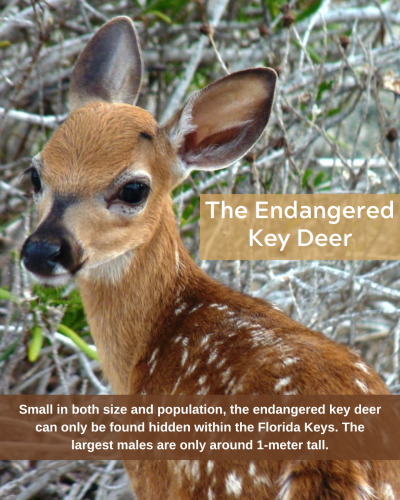 Key deer: Bambi, is that you? Small in both size and population, the endangered key deer can only be found hidden within the Florida Keys. They are the smallest subspecies of the North American white-tailed deer, with the largest males standing at only 1 meter tall. Though there are no natural predators in their Florida Keys area, habitat degradation, poachers, and motor vehicle collisions threaten their tiny population. Today, their population is slowly bouncing back through the National Key Deer Refuge.
Key deer: Bambi, is that you? Small in both size and population, the endangered key deer can only be found hidden within the Florida Keys. They are the smallest subspecies of the North American white-tailed deer, with the largest males standing at only 1 meter tall. Though there are no natural predators in their Florida Keys area, habitat degradation, poachers, and motor vehicle collisions threaten their tiny population. Today, their population is slowly bouncing back through the National Key Deer Refuge.
- Information from the U.S. Fish & Wildlife Service and image by Paul_dennehy (CC BY-NC 4.0).
These are just a handful of species that are endangered in Florida and haven’t begun to touch the surface of this iceberg.